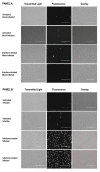Involvement of Pore Formation and Osmotic Lysis in the Rapid Killing of Gamma Interferon-Pretreated C166 Endothelial Cells by Rickettsia prowazekii
- PMID: 36006255
- PMCID: PMC9415803
- DOI: 10.3390/tropicalmed7080163
Involvement of Pore Formation and Osmotic Lysis in the Rapid Killing of Gamma Interferon-Pretreated C166 Endothelial Cells by Rickettsia prowazekii
Abstract
Rickettsia prowazekii, the bacterial cause of epidemic typhus in humans, proliferates mainly within the microvascular endothelial cells. Previous studies have shown that murine macrophage-like RAW264.7 cells are rapidly damaged if they are pretreated with gamma interferon (IFN-γ) and then infected with R. prowazekii. In the present study, the effects of IFN-γ and R. prowazekii on murine C166 endothelial cells were evaluated. In the IFN-γ-pretreated R. prowazekii-infected endothelial cell cultures, evidence of cell damage was observed within several hours after addition of the rickettsiae. Considerable numbers of the cells became permeable to trypan blue dye and ethidium bromide, and substantial amounts of lactate dehydrogenase (LDH) were released from the cells. Such evidence of cellular injury was not observed in the untreated infected cultures or in any of the mock-infected cultures. Polyethylene glycols (PEGs) of different nominal average molecular weights were used to assess the possible involvement of pore formation and osmotic lysis in this cellular injury. PEG 8000 dramatically suppressed LDH release, PEG 4000 partially inhibited it, and PEGs 2000 and 1450 had no effect. Despite its inhibition of LDH release, PEG 8000 did not prevent the staining of the IFN-γ-pretreated infected endothelial cells by ethidium bromide. These findings suggest that the observed cellular injury involves the formation of pores in the endothelial cell membranes, followed by osmotic lysis of the cells.
Keywords: Rickettsia prowazekii; cell death; cytokine; endothelial cell; epidemic typhus; host response; interferon; rickettsia.
Conflict of interest statement
The author declares no conflict of interest. The funders had no role in the design of the study; in the collection, analyses, or interpretation of data; in the writing of the manuscript; or in the decision to publish the results.
Figures








Similar articles
-
Relationship of tumor necrosis factor alpha, the nitric oxide synthase pathway, and lipopolysaccharide to the killing of gamma interferon-treated macrophage-like RAW264.7 cells by Rickettsia prowazekii.Infect Immun. 1994 Jun;62(6):2568-74. doi: 10.1128/iai.62.6.2568-2574.1994. Infect Immun. 1994. PMID: 7514579 Free PMC article.
-
Isolation of Rickettsia prowazekii with reduced sensitivity to gamma interferon.Infect Immun. 1989 Jun;57(6):1765-72. doi: 10.1128/iai.57.6.1765-1772.1989. Infect Immun. 1989. PMID: 2498207 Free PMC article.
-
Comparison of properties of virulent, avirulent, and interferon-resistant Rickettsia prowazekii strains.Infect Immun. 1991 May;59(5):1647-55. doi: 10.1128/iai.59.5.1647-1655.1991. Infect Immun. 1991. PMID: 1708354 Free PMC article.
-
Progress in rickettsial genome analysis from pioneering of Rickettsia prowazekii to the recent Rickettsia typhi.Ann N Y Acad Sci. 2005 Dec;1063:13-25. doi: 10.1196/annals.1355.003. Ann N Y Acad Sci. 2005. PMID: 16481486 Review.
-
The biology of rickettsiae.Infect Agents Dis. 1996 Jun;5(3):127-43. Infect Agents Dis. 1996. PMID: 8805076 Review.
References
-
- Fournier P.-E., Raoult D. Rickettsia. In: Trujillo M.E., Dedysh S., DeVos P., Hedlund B., Kämpfer P., Rainey F.A., Whitman W.B., editors. Bergey’s Manual of Systematics of Archaea and Bacteria. John Wiley & Sons, Inc.; Hoboken, NJ, USA: 2019. pp. 1–42. - DOI
LinkOut - more resources
Full Text Sources

